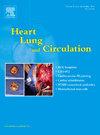急诊医疗服务对不同文化和语言移民人群急性冠脉综合征的应用
IF 2.2
4区 医学
Q2 CARDIAC & CARDIOVASCULAR SYSTEMS
引用次数: 0
摘要
背景:在急性冠脉综合征(ACS)中,紧急医疗服务(EMS)的使用减少了院前延误,增加了生存机会。然而,关于EMS在文化和语言多样性(CALD)患者中的应用的证据是相互矛盾的。本研究的目的是:1)检查ACS患者使用EMS的情况在CALD和非CALD人群之间是否存在差异;2)确定CALD患者使用EMS和非EMS的相关特征。方法:回顾性分析2016年1月至2021年6月期间在澳大利亚维多利亚州公立医院急诊科就诊的ACS病例,这些病例记录在维多利亚州卫生部维护的维多利亚州急诊最低数据集中。出生国家、首选语言和对翻译的需求定义了CALD状态。使用逻辑回归来描述与EMS和非EMS使用相关的特征。结果:在51,101例符合条件的ACS病例中,15,580例(30.5%)来自CALD组。CALD组EMS使用率低于非CALD组(61.9% vs 65.3%;结论:具有CALD背景的ACS患者EMS使用率较低。我们的研究结果确定了CALD人群的教育目标。本文章由计算机程序翻译,如有差异,请以英文原文为准。
Emergency Medical Service Use for Acute Coronary Syndrome in Culturally and Linguistically Diverse Immigrant Populations
Background
In acute coronary syndrome (ACS), emergency medical service (EMS) use reduces pre-hospital delay and increases the chances of survival. However, evidence regarding EMS use in culturally and linguistically diverse (CALD) patients is conflicting. This study aimed to i) examine whether EMS use in patients with ACS varies between CALD and non-CALD populations and ii) identify characteristics associated with EMS and non-EMS use in CALD patients.
Method
This is a retrospective analysis of ACS cases presented to emergency departments of public hospitals in Victoria, Australia between January 2016 and June 2021, as recorded in the Victorian Emergency Minimum Dataset maintained by the Victorian Department of Health. Country of birth, preferred language, and the need for an interpreter defined CALD status. Logistic regression was used to describe the characteristics associated with EMS and non-EMS use.
Results
Of the 51,101 eligible ACS cases, 15,580 (30.5%) were from the CALD group. EMS use was lower in CALD than in non-CALD groups (61.9% vs 65.3%; p<0.001; adjusted odds ratio [aOR] 0.78; 95% confidence Interval [CI] 0.75–0.81). In CALD patients, the odds of EMS use increased with advancing age, living alone (aOR 1.45; 95% CI 1.24–1.70), self-referral (aOR 4.53; 95% CI 3.97–5.17), hospital presentation in the year 2020 (aOR 1.16; 95% CI 1.03–1.31) or 2021 (aOR 1.20; 95% CI 1.30–1.39), and being diagnosed with acute myocardial infarction (aOR 1.36; 95% CI 1.26–1.39). Reduced odds of EMS use were associated with being born in Southeast Asia (aOR 0.71; 95% CI 0.57–0.89), Northeast Asia (aOR 0.57; 95% CI 0.42–0.77), and the Americas (aOR 0.59; 95% CI 0.43–0.80); speaking a South Asian language (aOR 0.65; 95% CI 0.51–0.83); and hospital presentation in summer (aOR 0.90; 95% CI 0.82–0.99).
Conclusions
EMS use was lower in patients with ACS with CALD backgrounds. Our findings have identified CALD population subgroups to target with education.
求助全文
通过发布文献求助,成功后即可免费获取论文全文。
去求助
来源期刊

Heart, Lung and Circulation
CARDIAC & CARDIOVASCULAR SYSTEMS-
CiteScore
4.50
自引率
3.80%
发文量
912
审稿时长
11.9 weeks
期刊介绍:
Heart, Lung and Circulation publishes articles integrating clinical and research activities in the fields of basic cardiovascular science, clinical cardiology and cardiac surgery, with a focus on emerging issues in cardiovascular disease. The journal promotes multidisciplinary dialogue between cardiologists, cardiothoracic surgeons, cardio-pulmonary physicians and cardiovascular scientists.
 求助内容:
求助内容: 应助结果提醒方式:
应助结果提醒方式:


